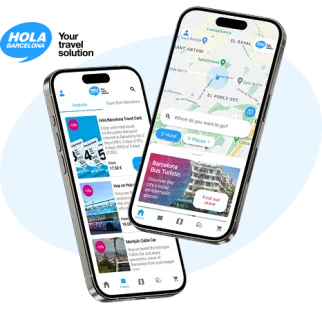Municipal Conservatory of Barcelona – La Concepció Market
The artistic transition from Modernisme to Noucentisme
On the same block in the Eixample you can find two buildings with very different architectural characteristics. The older of the two is La Concepció Market, which is covered by an imposing iron structure that is visible from the street. It was constructed in 1888 at the height of the Modernisme period. The Municipal Conservatory of Barcelona, which was built between 1916 and 1927, is located close by. Although its predominant style is Noucentisme you can see how Modernisme influenced the design of the building.

Barcelona Bus Turístic, on the Hola Barcelona app
Your app for visiting the city with the Barcelona Bus Turístic: routes, stops and the most iconic places. A comfortable way to carry your tickets too!
Why visit the Municipal Conservatory of Barcelona and La Concepció Market?
Both La Concepció Market and the Municipal Conservatory of Barcelona are works of immense architectural value. They have in common that they were built in the city’s golden age, albeit in two very different styles.
La Concepció Market, which is composed of three iron structures, was designed in 1887 by the architect Antoni Rovira i Trias and restored from 1996 to 1998 based on a project developed by Albert de Pineda i Álvarez. The building stands out due to its size – it covers a surface area of 4,000 m² – and its gabled roof of ceramic glazed tiles characteristic of the Modernisme style. The central structure, which is the widest and tallest, is illuminated from the sides over the tiled roofs of the lateral structures, and the main facades are supported by a base of stone from Montjuïc finished with cast and wrought iron rails.
The architect of La Concepció Market, Rovira i Trias, designed other important buildings in the city, such as the Sant Antoni Market, in addition to a number of streets, including a square in the Gràcia district, which bears his name, and Passatge de la Banca, where the Wax Museum is. He also won the competition held in 1859 by Barcelona City Council to develop the Eixample. However, the project proposed by Ildefons Cerdà was finally selected for implementation.
For its part, the Municipal Conservatory of Barcelona is in a building that forms part of the city’s catalogue of protected buildings and was built by the municipal architect Antoni de Falguera from 1916 to 1927. Its outstanding features are the two towers on the main facade, which combine the Modernista and Noucentista styles and show evidence of the influence of Josep Puig i Cadafalch, who was Falguera’s teacher and the architect of, among other buildings, Casa de les Punxes.
How do you get to the Municipal Conservatory of Barcelona and La Concepció Market?
The Municipal Conservatory of Barcelona and La Concepció Market are located on the block delimited by Carrer de València, Carrer del Bruc, Carrer d’Aragó and Carrer de Girona, in the right side of the Eixample district. You can easily reach them from the Casa Batlló – Fundació Antoni Tàpies stop on the Red Route and Blue Route of Barcelona Bus Turístic by following Carrer de València.
For the most curious of you
- Did you know? Very close to La Concepció Market is one of Barcelona’s most peculiar churches. It is the Basílica de la Puríssima Concepció i Assumpció de Nostra Senyora (Basilica of the Immaculate Conception and Assumption of Our Lady). The church was built in the 13th century on land that was subsequently expropriated to open up Via Laietana, so from 1871 to 1888 it was moved, stone by stone, to its current site. The Gothic bell tower of another church that was also threatened with demolition, Sant Miquel, was also added to it.
- Local’s tip: If you want to buy flowers, the florists at La Concepció Market are open 24 hours a day, 365 days a year. And, if you are a music lover, you can enjoy free concerts organised by the conservatory’s students.
- A must: To see different architectural currents not only on the same block, but also combined in the same building.





















